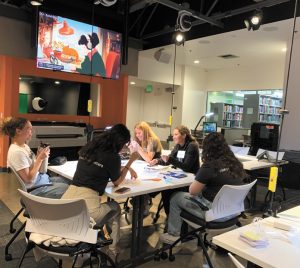The concept of participatory service in libraries stands out as one of the foremost ways modern libraries engage in growing their communities. More than just a book repository, libraries have become community hubs—places for engaging in and sharing creativity. Participatory service is more than library social media accounts or measured survey input, it is a dedication to growing and sustaining community engagement through interactive connection. As Casey (2011) explains, “The participatory library engages and queries its entire community and seeks to integrate them into the structure of change”. While public input is the catalyst for participatory service, it is only the beginning of a multifaceted system which aims to create a library culture of active involvement and community planning and commitment. As Casey & Savastunik (2007) describe in Library 2.0, the idea of a top-down service model has become obsolete; forcing libraries to evolve the way they structure their resources, and, ultimately, leading to the evolution of the participatory service model (p. 61). The importance of surveys, comment cards, and online input from patrons should not be understated—for it is this input which drives the development of participatory services within the physical library space. With this community input, libraries around the world can create programs, services, and daily interactions that increase participation in their physical library spaces; empowering library management to develop meaningful, quality services that fit the needs of their communities.
As libraries have evolved, the resources available have become increasingly focused on developing a framework of active participation within the physical space of the library. Through interactive display features within the library, users can have daily engagement with varied forms of participatory culture.

DOK Library, Netherlands.
This can be seen in libraries like DOK in the Netherlands, where a large touchscreen Surface table is used to display Flickr photographs from the library account, allowing patrons to interact with the device by browsing and downloading displayed photos of library users (Stephens, 2011). DOK library also uses this Surface table in their interactive Heritage Browser, a tool that implements collaboration through photographic story sharing (Boekesteijn, 2011). These tools blends the online and physical community spaces of the library, allowing users to lend their photos, stories, and other ideas to this digital space to be accessed by other library users to exchange information through the Surface table interface. This blending of online and physical communing is a brilliant way to showcase libraries’ evolution of innovation in participatory service models.
To take this idea of daily accessible forms of interactivity further, it is important to mention library makerspaces. These spaces are dedicated to fostering creativity and community, on-site, through their available resources. This is evidenced in spaces like YOUmedia at Chicago Public Library (Chicago Public Library, 2016) and the James B. Hunt, Jr. Library at NC State University (NC State, 2013). Through these supremely interactive spaces, library goers are encouraged to fully immerse themselves in the library space and its community. NC State describes their library space through experience,

OctaviaLab, LAPL
innovation, creation, collaboration, immersion, and education (NC State, 2013), encapsulating the true form of the participatory service model. LAPL houses the OctaviaLab, a maker space chalked full of creative tools and equipment, with a variety of learning opportunities available to users. These makerspaces are used as a means for community meeting and sharing. In these spaces, peer interaction and learning naturally lends itself to community development. By engaging in makerspaces and the programs and services they offer, community growth and participatory culture is fostered and encouraged through direct communication, learning, and creating with likeminded peers, as well as library staff. Extending these tools for makers outside of the library walls, library of things and tool lending libraries provide further participatory service to patrons. With these service forms, libraries once again blend their engagement from within and outside of the library’s physical space.
Using community input to guide participatory service has led libraries to services that engage their communities online, at the library, and at home. No longer simply a place for books, libraries have become community hubs for creativity and peer-to-peer learning and networking. Libraries have transformed into places of interactive communication, where experience-oriented learning leads the way in participatory service and library culture (Rasmussen, 2016). Holding these concepts in high esteem, it is my professional goal to continue the work in implementing this model of open, creative participatory discourse and service– to ensure libraries remain centers of culture, creativity, and learning in our communities for many years to come.
References:
Boekesteijn, E. (2011, February 15). DOK Delft takes user generated content to the next level. Tame the Web. https://tametheweb.com/2011/02/15/dok-delft-takes-user-generated-content-to-the-next-level-a-ttw-guest-post-by-erik-boekesteijn/
Casey, M.E., & Savastinuk, L.C. (2007). Library 2.0: A Guide to Participatory Library Service. Information Today.
Chicago Public Library. (2018, April 11). YOUmedia at CPL. [Video]. YouTube. https://www.youtube.com/watch?v=v8G4nnlgKmk
NC State. (2013, April 3). NC state university’s James B. Hunt, Jr. library. [Video]. YouTube. https://www.youtube.com/watch?v=scyQPk6n0xA
Rasmussen, C.H. (2016, October). The participatory public library: the Nordic experience. New Library World. 117 (9-10) 546–556. https://doi.org/10.1108/NLW-04-2016-0031
Stephens, M. (2011, November 7). Erik Demonstrates Surface & Flickr App. [Video]. YouTube. https://www.youtube.com/watch?v=OCpY5zTv2Xo
Leave a Reply